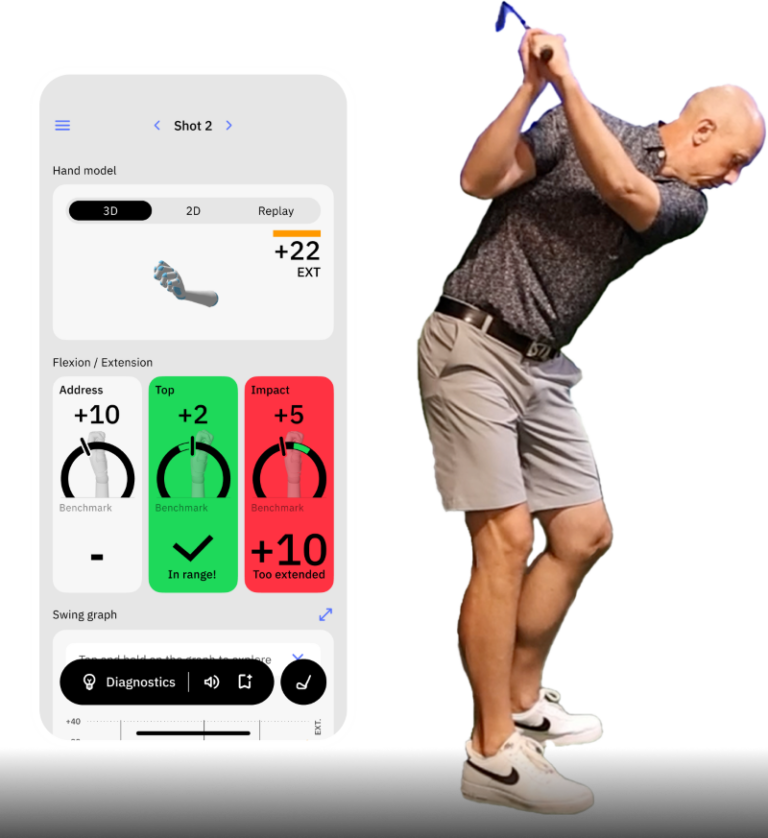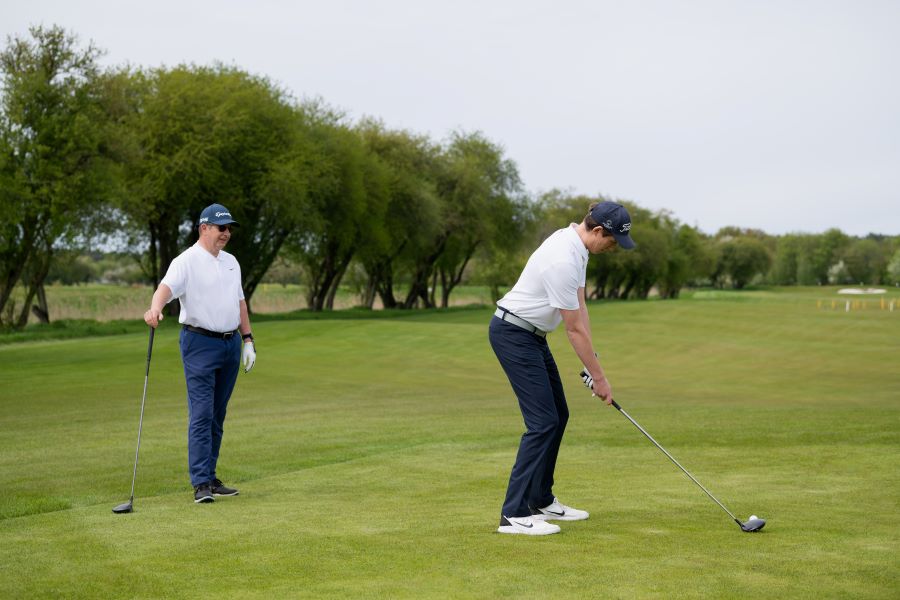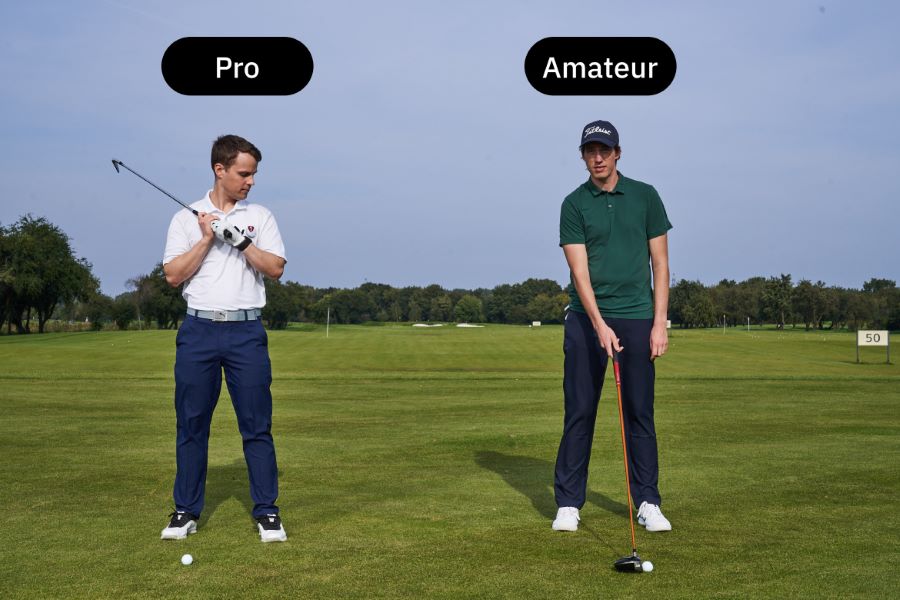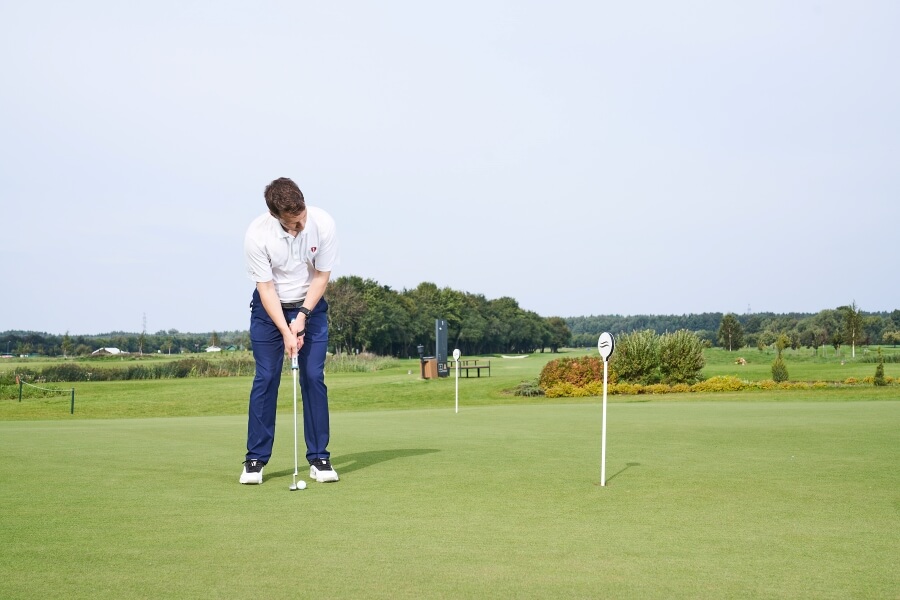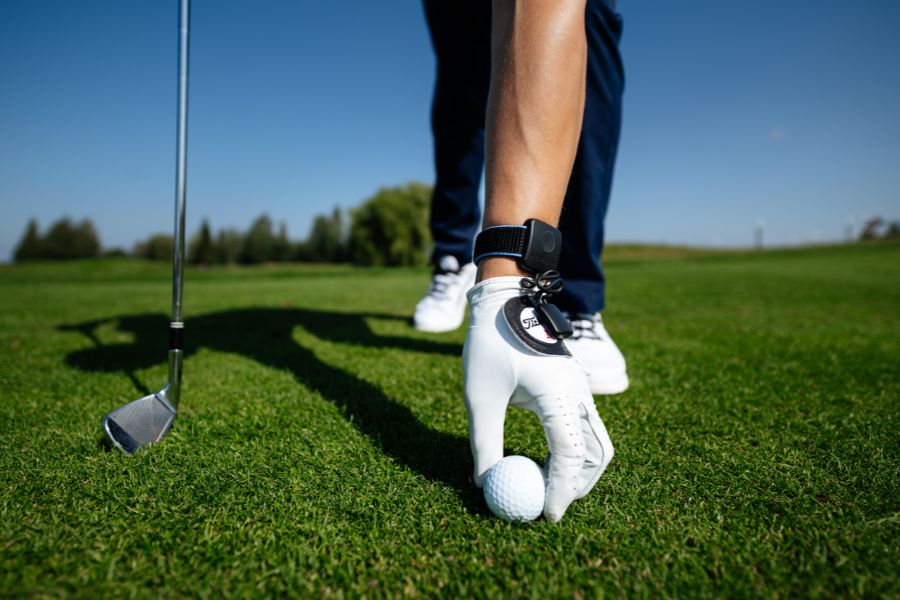Understanding Shot Dispersion in Golf (A Player’s Guide to Accuracy)
Great players have better misses. Golf is a game of misses.
When you start missing the pin by 5 yards instead of 15 yards, your shot dispersion improves, and your handicap drops along with it.
We will take you on a deep dive into shot dispersion so you can use it to understand your game and how to start approaching your strategy on the course.
Key Takeaways
Here are a few key takeaways to understand about shot dispersion. If you don’t have time to read our entire guide, take this information with you to make some progress right away.
- Your typical shot dispersion is likely much wider than you think; test yourself on the range to see how far away from your target you are.
- Good golfers who analyze their shot dispersion pattern may sometimes aim shots completely off the green to give themselves the best shot of ending up on the green.
- To lower your golf shot dispersion ranges, you must control the clubface angle at impact.
- When determining golf shot dispersion and its impact on your game, think about the width of the shot as well as the depth.
If you prefer to learn by watching a video; this detailed video from Rob Cheney will give you insights into how to work on your shot dispersion and why this is such an important factor when working towards becoming a better player.
Contents
What is Shot Dispersion?
Shot dispersion is the average of your misses. If you have a pin 100 yards in front of you, you will aim right for it, but not all of your shots will hit the target. You will hit shots left, right, long, and short of the target.
That is your golf shot dispersion.
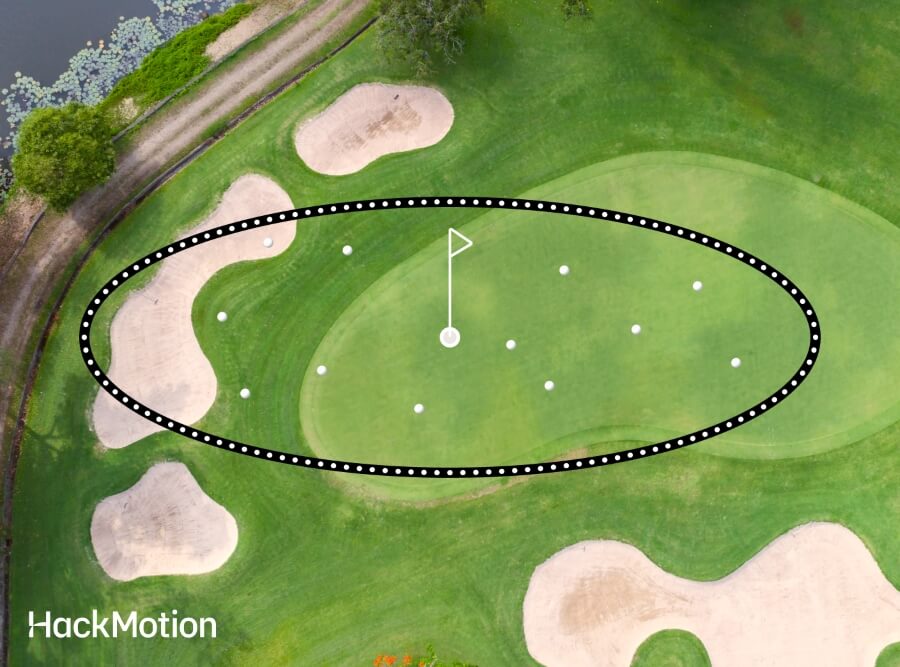
Golfers with lower dispersion ranges are more consistent and typically have lower handicaps.
When you better understand your shot dispersion, you can make smart decisions on the course.
Shot Dispersion Chart by Handicap
When looking at golf shot dispersion, you have to consider the width and depth of the shot dispersion.
Lower handicap golfers (single digits) have a shot dispersion of 30 yards or less with a 7 iron when it comes to width. This means if you aim at a pin, the dispersion would be 15 yards left or right of the pin.
Professionals would have a dispersion of less than 15 yards total (so 7.5 yards left or right of the target).
As far as depth is concerned, the dispersion is a little lower. Most golfers miss the shots short of the target more than long.
Average players have dispersion ranges of about 30 yards long when it comes to depth. If you hit a 115-yard shot, the thought would be the ball can travel anywhere from 100 to 130 yards. However, we see most misses on this shot in the 85 to 115 yard range.
| Handicap Level | Approximate Dispersion Width (Yards) | Approximate Dispersion Depth (Yards) |
|---|---|---|
| Scratch (0) | 15-20 | 10-15 |
| 5 | 20-25 | 15-20 |
| 10 | 25-30 | 20-25 |
| 15 | 30-35 | 25-30 |
| 20 | 35-40 | 30-35 |
| 25 | 40-45 | 35-40 |
Why is Shot Dispersion so Important to Understand
Understanding your shot dispersion significantly affects scoring, accuracy, and club selection. You can get some details on your shot dispersion using a launch monitor.
Without a launch monitor, it’s possible to use a well-measured target and learn your shot dispersion by working on the range.
When working with a launch monitor, follow these steps to gain shot dispersion information:
- Position the Launch Monitor: Place the launch monitor in the recommended position relative to the hitting area. This is typically a few feet behind and to the side of the ball.
- Calibrate the Device: Follow the manufacturer’s instructions to calibrate the launch monitor for accuracy.
- Consistent Stance: Ensure you are using a consistent stance and setup for each shot to help eliminate variables.
- Hit Multiple Shots: Hit a series of shots with the same club. For meaningful data, aim for at least 20-30 shots. You can repeat this for multiple clubs but start with one at a time. In other words, hit all shots with your 7-iron or 8-iron.
- Review Shot Data: Look at the data collected by the launch monitor for each shot. Pay attention to carry distance, ball speed, launch angle, and side spin.
- Identify Dispersion Pattern: The launch monitor software will typically provide a visual representation of your shots, showing the dispersion pattern.
- Width and Depth Analysis: Analyze the width (lateral dispersion) and depth (longitudinal dispersion) of your shots.
- Identify Tendencies: Note any common tendencies, such as a bias to the left or right, or consistently short or long shots.
Improving Accuracy
Paying attention to your shot dispersion can help you understand where your game really needs help.
You may look at the fact that you hit 8/18 greens in regulation and be kind of disappointed. However, if you missed them by a yard or two, your game could be very close to being a lot better.
If you are missing greens by 30 or 40 yards, the situation is different, and your golf swing and clubface control likely need work.

Club Selection
Knowing your shot dispersion will also help you choose the right club off the tee and when approaching the greens.
Let’s say the pin is in the front of the green, and it’s 105 yards away. You hit your pitching wedge 105 yards but have a dispersion (depth) of 10 yards.
Does it make sense to hit the pitching wedge into the green?
Probably not. The 9 iron is your 115-yard club with a dispersion of 10 yards; this leaves you with a perfect shot a little long and a slightly less-than-perfect shot that could go in the hole.
This type of thinking on the golf course is something that most amateurs need to be doing.
Lowering Scores
Finally, if you can recognize that you have an issue with shot dispersion and then make adjustments to club selections and decisions on the course, you will lower your scores.
When your misses are closer to the hole, you score better. Think about hitting shots that miss but are still on the green instead of being in the water or a bunker.
Factors Influencing Shot Dispersion
Now that you understand the importance of shot dispersion, it’s time to examine the factors that influence it. These include skill level, golf club selection, course conditions, and mental game.
Handicap
The lower your handicap, the lower your dispersion in golf. Better players are likely to be in less trouble when they miss their shots. New players have higher shot dispersion and very unpredictable shots.
An experienced player typically knows they will miss the shot 5 or 10 yards left when they miss. A higher handicapper isn’t always sure if the ball is going left or right.
Getting to the point of knowing if the ball is going left or right is a big turning point for golfers.
Golf Club in Your Hand
A 15 yard miss with a driver may leave you on the edge of the fairway. A 15 yard miss with a wedge puts you in a bunker.
Dispersion changes with the club you have in your hand. The longer the club, the higher the dispersion. Yes, this includes the putter. When you miss a putt, it should be by inches; when you miss with the driver, expect 10+ or even 20+ yards.
Golf Course Conditions
Golf course conditions and difficulty can impact dispersion. If the course is windy or playing hard from being dry, the ball may miss further than it does when the course is wet and receptive to shots.
For instance, if a 20 handicapped amateur player went to play a US Open course, their dispersion would be a lot higher than usual. Why? The course conditions are much harder, and you must have spin and control to hit great shots that stay in place.
The Mental Game
The mental game may not seem like it will change your dispersion, but it will.
If you are approaching a green with water or sand all around it, your confidence and mindset will likely come into play when measuring shot variation.
You often see this when a golfer stands on a driving range and tests out a new driver. They have no pressure on them, they swing with ease, and they hit it incredibly straight.
When that club goes out on the course for the first time, the results are entirely different. Why? There is trouble, scoring counts, and many golfers try to control the golf ball through impact.
How to Decrease Golf Shot Dispersion
Golf shot dispersion should be decreased or become tighter if you want to play better golf. It’s as simple as this: would you rather be 5 yards or 10 yards from the pin?
Here are some of the best ways to decrease golf shot dispersion and give yourself makeable birdie and par putts.
Play with the Right Clubs
You don’t need the latest golf club releases to the market in order to have low dispersion. However, you do need to have golf clubs that fit the needs of your game.
If you play with a shaft that is too stiff or a clubhead that is unforgiving, your dispersion will not be as tight.
Higher handicappers should consider game-improvement clubs that make it easier to launch the ball, get distance, and keep the golf ball straight.
Practice Consistency in Setup
Another mistake golfers make that leads to issues with shot dispersion is the inconsistency in setup.
When your feet, hands, head, shoulders, and hips are not in the same position each time, you can’t expect the same shot.
When working on the driving range, you should make sure to practice consistency in your setup. A little tweak of your shoulder angle or hip angle may be enough to lose your shot well left or right of the target.
On the course incorporate a pre shot routine into each shot. This pre shot routine will improve your ability to consistently set up to hit the golf ball.
Learn to Control the Clubface
Perhaps the most important and effective way to decrease golf shot dispersion is to work on your wrist angles in your golf swing. The wrists control the angle of the clubface.
When wrists are in the proper position at setup, the top of the backswing, and then again at impact, your golf shot has a higher percentage of heading directly toward the target.
HackMotion is like having a coach with you at the range. You can track your wrist angles in real-time throughout your swing and make adjustments.
In this video, Rob Cheney gives you a great drill to help control your shot dispersion and hit golf shots that end up near your target.
He talks about how excessive wrist action after impact is a major concern for players and hitting practice shots where you stop the club short on the follow through can help to control this.
Golf Shot Dispersion on Course Example
When you look at a hole like this one with bunkers surrounding the front and the left side, it’s important to consider your dispersion.
Let’s look at the average dispersion of a golfer with a 7 iron approaching this green.

An average golfer will have a dispersion area of about 30 yards.
For that golfer to aim directly at the pin, the shot that misses left will be well off the green. If you can move that golf ball over just a little and aim for the pin, almost all misses could be on the green.
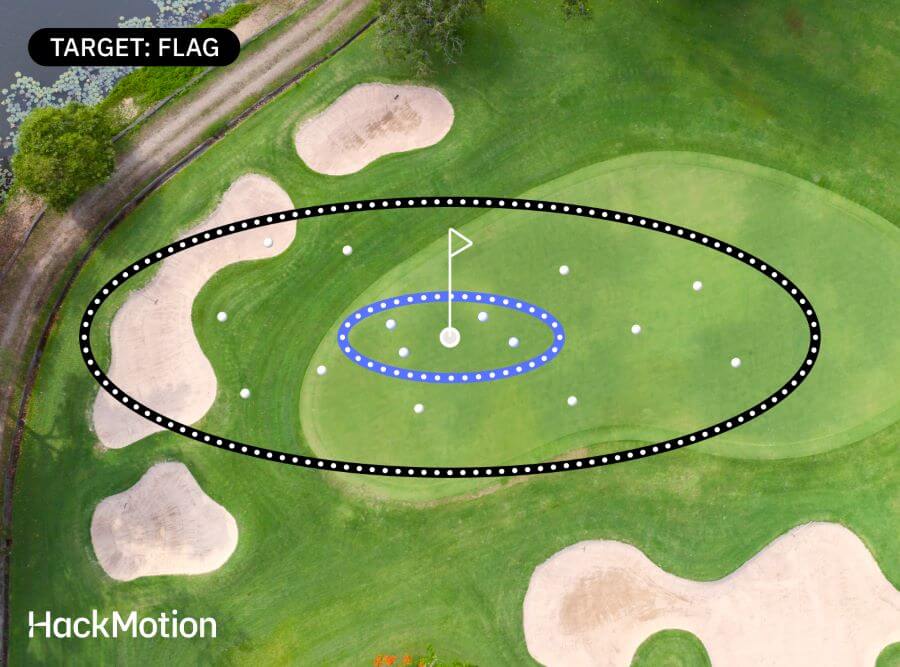

Golfers who aim at the pin don’t necessarily make more birdies. In fact, they often make higher numbers than the golfers who go for the center of the green.
Even professionals do not always aim at the pin.
The other thing to consider is depth.
Coming up short here isn’t an option. Instead, it’s best to go one club up and fly it a little over the center of the green, just enough to keep the ball in the grass.
Learning your carry distances, understanding your dispersion data and practicing with the HackMotion to deliver a square clubface angle is the best strategy.
Final Thoughts
Shot dispersion in golf is a factor that all players should be paying attention to. Your approach to the golf course should change considerably when you understand the range of where your golf shots can end up.
If you want to decrease your dispersion, use HackMotion to understand how to control the clubface.
Delivering a square clubface to the golf ball takes a bit of time and practice, but it’s the key to a lower handicap.
